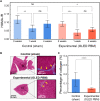OLED catheters for inner-body phototherapy: A case of type 2 diabetes mellitus improved via duodenal photobiomodulation
- PMID: 37656783
- PMCID: PMC10854432
- DOI: 10.1126/sciadv.adh8619
OLED catheters for inner-body phototherapy: A case of type 2 diabetes mellitus improved via duodenal photobiomodulation
Abstract
Phototherapeutics has shown promise in treating various diseases without surgical or drug interventions. However, it is challenging to use it in inner-body applications due to the limited light penetration depth through the skin. Therefore, we propose an organic light-emitting diode (OLED) catheter as an effective photobiomodulation (PBM) platform useful for tubular organs such as duodenums. A fully encapsulated highly flexible OLED is mounted over a round columnar structure, producing axially uniform illumination without local hotspots. The biocompatible and airtight OLED catheter can operate in aqueous environments for extended periods, meeting the essential requirements for inner-body medical applications. In a diabetic Goto-Kakizaki (GK) rat model, the red OLED catheter delivering 798 mJ of energy is shown to reduce hyperglycemia and insulin resistance compared to the sham group. Results are further supported by the subdued liver fibrosis, illustrating the immense potential of the OLED-catheter-based internal PBM for the treatment of type 2 diabetes and other diseases yet to be identified.
Figures






Similar articles
-
Duodenal Dual-Wavelength Photobiomodulation Improves Hyperglycemia and Hepatic Parameters with Alteration of Gut Microbiome in Type 2 Diabetes Animal Model.Cells. 2022 Nov 3;11(21):3490. doi: 10.3390/cells11213490. Cells. 2022. PMID: 36359885 Free PMC article.
-
Exploring the Safety and Efficacy of Organic Light-Emitting Diode in Skin Rejuvenation and Wound Healing.Yonsei Med J. 2024 Feb;65(2):98-107. doi: 10.3349/ymj.2023.0125. Yonsei Med J. 2024. PMID: 38288650 Free PMC article.
-
Intestinal electrical stimulation attenuates hyperglycemia and prevents loss of pancreatic β cells in type 2 diabetic Goto-Kakizaki rats.Nutr Diabetes. 2019 Feb 6;9(1):4. doi: 10.1038/s41387-019-0072-2. Nutr Diabetes. 2019. PMID: 30728346 Free PMC article.
-
The quest for a model of type II diabetes with nephropathy: the Goto Kakizaki rat.J Nephrol. 2004 Nov-Dec;17(6):769-73. J Nephrol. 2004. PMID: 15593049 Review.
-
Selectively bred rodent models for studying the etiology of type 2 diabetes: Goto-Kakizaki rats and Oikawa-Nagao mice.Endocr J. 2023 Jan 30;70(1):19-30. doi: 10.1507/endocrj.EJ22-0253. Epub 2022 Dec 7. Endocr J. 2023. PMID: 36477370 Review.
Cited by
-
Plant-derived hydrogel and photosynthetic nano-units for myocardial infarction therapy.Nat Commun. 2025 Aug 18;16(1):7678. doi: 10.1038/s41467-025-62020-5. Nat Commun. 2025. PMID: 40825772
-
Advances in Photonic Materials and Integrated Devices for Smart and Digital Healthcare: Bridging the Gap Between Materials and Systems.Adv Mater. 2025 Feb 4:e2416899. doi: 10.1002/adma.202416899. Online ahead of print. Adv Mater. 2025. PMID: 39905874 Review.
-
Advancing Cancer Treatment and Diagnosis: A Review on Photodynamic Therapy Using OLED Technology.Molecules. 2025 Mar 14;30(6):1305. doi: 10.3390/molecules30061305. Molecules. 2025. PMID: 40142080 Free PMC article. Review.
-
A wearable and stretchable dual-wavelength LED device for home care of chronic infected wounds.Nat Commun. 2024 Oct 30;15(1):9380. doi: 10.1038/s41467-024-53579-6. Nat Commun. 2024. PMID: 39477919 Free PMC article.
References
-
- G. Hong, X. Gan, C. Leonhardt, Z. Zhang, J. Seibert, J. M. Busch, S. Bräse, A brief history of OLEDs—Emitter development and industry milestones. Adv. Mater. 33, 2005630 (2021). - PubMed
-
- J. Song, H. Lee, E. G. Jeong, K. C. Choi, S. Yoo, Organic light-emitting diodes: Pushing toward the limits and beyond. Adv. Mater. 32, 1907539 (2020). - PubMed
-
- C. Murawski, M. C. Gather, Emerging biomedical applications of organic light-emitting diodes. Adv. Opt. Mater. 9, 2100269 (2021).
-
- Y. Jeon, H. Choi, M. Lim, S. Choi, H. Kim, J. H. Kwon, K. Park, K. C. Choi, A wearable photobiomodulation patch using a flexible red-wavelength OLED and its in vitro differential cell proliferation effects. Adv. Mater. Technol. 3, 1700391 (2018).
-
- S. K. Attili, A. Lesar, A. McNeill, M. Camacho-Lopez, H. Moseley, S. Ibbotson, I. D. W. Samuel, J. Ferguson, An open pilot study of ambulatory photodynamic therapy using a wearable low-irradiance organic light-emitting diode light source in the treatment of nonmelanoma skin cancer. Br. J. Dermatol. 161, 170–173 (2009). - PubMed
MeSH terms
LinkOut - more resources
Full Text Sources
Medical

